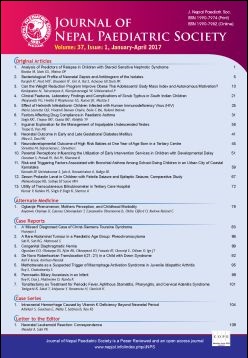Serum Prolactin Level in Children with Febrile Seizure and Epileptic Seizure; Comparative Study
DOI:
https://doi.org/10.3126/jnps.v37i1.16502Keywords:
Postictal period, Serum prolactin level, febrile seizure, epileptic seizureAbstract
Introduction: Transient hyperprolactinaemia has been reported to follow unprovoked seizures, a finding proposed to be useful in the differential diagnosis of epilepsy. On this basis we conducted a study with an objective to compare the postictal serum prolactin level in children with febrile seizures (FS) and epileptic seizures (ES) to evaluate, whether serum prolactin (PL) could be used a predictor in the diagnosis of ES.
Material and Methods: This was a prospective comparative study was conducted on 52 children (26 in febrile seizures group and 26 in epileptic seizure group) in the age group of six months to five years. Children with CNS infection, developmental delay, structural CNS defects or neurological abnormality, metabolic disorders and those on drugs, known to have altered serum prolactin level were excluded. Blood for estimation of serum prolactin was collected within 180 minutes of occurrence of seizure. Level of serum prolactin was quantitatively assayed by chemiluminescence method and the levels were considered high, if values were greater than 23 ng/ml, which is the upper limit of normal for all age groups and both sex.
Results: The mean serum prolactin level in epileptic seizures group was 25 ng/ml and that of febrile seizures group was 10.72 ng/ml. High level of serum prolactin was noted in 17 children (77.2%) with GTCS and 3 children (75%) with CPS. None of the children with febrile seizures had significant raise in the level of serum prolactin.
Conclusion: There is a significant rise in serum prolactin level in children with epileptic seizures compared to febrile seizures, if measured within 3 hours of occurrence of seizures. Thus, the post-ictal serum prolactin level can be used as an additional investigation to diagnose or predict epileptic seizures in children.
Downloads
Downloads
Published
How to Cite
Issue
Section
License
Authors who publish with this journal agree to the following terms:
Authors retain copyright and grant the journal right of first publication with the work simultaneously licensed under a Creative Commons Attribution License that allows others to share the work with an acknowledgement of the work's authorship and initial publication in this journal.
Authors are able to enter into separate, additional contractual arrangements for the non-exclusive distribution of the journal's published version of the work (e.g., post it to an institutional repository or publish it in a book), with an acknowledgement of its initial publication in this journal.
Authors are permitted and encouraged to post their work online (e.g., in institutional repositories or on their website) prior to and during the submission process, as it can lead to productive exchanges, as well as earlier and greater citation of published work (See The Effect of Open Access).



